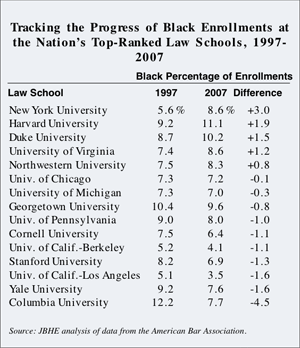| The Decline in Black Enrollments at the Nation’s Highest-Ranked Law Schools Over the past decade, law school enrollments of black students nationwide have declined slightly. This downward trend also prevails at the nation’s highest-ranked law schools. Over the 10-year period, black enrollments have dropped at 10 of the nation’s 15 highest-ranked law schools. The leading law firms in this country recruit their associates at the nation’s 15 leading law schools. Many of these highly selective firms now offer starting salaries to inexperienced first-year associates of up to $150,000. Also, the nation’s top law schools typically produce the law clerks for the nation’s Supreme Court justices and other federal judgeships. Tracking black progress at these elite educational institutions is an important barometer for gauging how blacks are faring in reaching the top echelons of the legal profession. On page 46 of the Autumn 2007 print issue of JBHE we publish a table showing black enrollments at all of the 194 law schools in the United States that are accredited by the American Bar Association. But this current snapshot of the status of black enrollments at this very large number of law schools does not tell us which of the nation’s most prestigious law schools are showing progress in increasing their black enrollments. To this end we present figures here on the progress of black enrollments at the nation’s 15 highest-ranked law schools over the past 10-year period.
Dean Richard Revesz of the New York University law school told JBHE that “a diverse student body has been and continues to be a priority.” He said that the school has instituted a number of strategies to increase black enrollments. One program offers scholarships to students who are the first in their families to enroll in a professional school and who come from backgrounds with a severe economic disadvantage. The law school conducts extensive recruiting activities at historically black colleges and universities and other institutions with large percentages of African-American students. Also, the black law school student association at NYU has been active in recruiting students through telephone campaigns and through visits to their alma maters. Among the top schools, Harvard University ranks second in increasing black enrollments over the past decade. During the period, the percentage of blacks in the student body at Harvard Law School increased by nearly two percentage points. There were 153 black students at Harvard Law School in 1997. In 2007 there were 190 black students enrolled at the law school, an increase of 24 percent. Elena Kagan, dean of Harvard Law School, told JBHE, “We are seeing an ever stronger black applicant pool, which allows us to identify an increasing number of black students who we think will make Harvard Law School a better place. We are also doing quite well on our yield of admitted black students.” The only other high-ranking law schools to show an increase in their percentage of black students over the past decade were Duke University, the University of Virginia, and Northwestern University. At Yale Law School, the nation’s highest-ranked institution, black enrollments declined 1.6 percentage points from 9.2 percent to 7.6 percent in the past decade. There were 53 black students enrolled at Yale Law School in 1997. Ten years later there were 44 black students, a decline of 17 percent. Columbia University School of Law had the steepest decline in black enrollments over the past decade. In 1997 blacks were 12.2 percent of all students at the law school. A decade later black enrollments had dropped to 7.7 percent. In numbers, black enrollments at Columbia’s law school decreased from 135 in 1997 to 95 in 2007, a drop of nearly 30 percent. It is likely that Columbia Law School, which in recent years may have lost some academic standing in comparison to a rising reputation of NYU, also may be losing strong black candidates on account of NYU’s aggressive policy of recruiting high-achieving black students. E. Nkonye Iwerebon, dean of admissions at Columbia Law School, told JBHE, “I am not aware of any reason for the decline in African-American representation among our students.” It appears that the Columbia law school has shown a positive reversal of the recent 10-year trend. Dean Iwerebon advises JBHE that blacks make up 10 percent of the current entering class at the law school.
|
|




 Over the past decade only five of the nation’s 15 highest-ranked law schools have shown an increase in their enrollment percentages of blacks. Ten of the 15 leading schools posted declines in black enrollments. A major exception was the law school at New York University. Black enrollments at the NYU law school climbed from 5.6 percent in 1997 to 8.6 percent in 2007. In raw numbers, black enrollments at the NYU law school increased from 74 in 1997 to 124 in 2007, an increase of 68 percent. In the past, the law school at New York University had been criticized for a lukewarm commitment to affirmative action. However, it now appears that the law school has made a solid and successful effort to increase black enrollments.
Over the past decade only five of the nation’s 15 highest-ranked law schools have shown an increase in their enrollment percentages of blacks. Ten of the 15 leading schools posted declines in black enrollments. A major exception was the law school at New York University. Black enrollments at the NYU law school climbed from 5.6 percent in 1997 to 8.6 percent in 2007. In raw numbers, black enrollments at the NYU law school increased from 74 in 1997 to 124 in 2007, an increase of 68 percent. In the past, the law school at New York University had been criticized for a lukewarm commitment to affirmative action. However, it now appears that the law school has made a solid and successful effort to increase black enrollments.